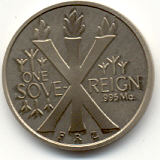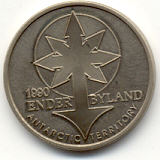 |
 |
| Enderbyland | |||||||||||||||||||||||||||||||||||||||||||||||||||||||||||||||||||||||||||||||||||||||||||||||||||||||||||||||||||
|
Enderbyland
is a region of Antarctica between Queen Maud Land and Wilkes Land, claimed
by Australia
as part of the
Australian Antarctic Territory. Enderbyland is named for the whaling
company, Samuel Enderby & Sons, which financed the 1831 expedition that
discovered it. Fred Richard Zinkann has produced this One Sovereign 1990 coin of Antarctic Territory - Enderbyland. The diameter of the coin is 25.5mm. His initials are also visible on the bottom of the coin as FRZ. Reverse: Enflamed Runic Symbol. Obverse: Arrowed Symbol He has produced coins in unusual medals having higher atomic number and density for experimental purposes, to see what they look like in coinage form and how they might strike up for later designs. The quantity/patterns of this coin were produced in the following metals. |
|||||||||||||||||||||||||||||||||||||||||||||||||||||||||||||||||||||||||||||||||||||||||||||||||||||||||||||||||||
 |
 |
||||||||||||||||||||||||||||||||||||||||||||||||||||||||||||||||||||||||||||||||||||||||||||||||||||||||||||||||||
|
Molybdenum is a
silvery-white element usually used as an alloying addition to steels and
titanium alloys, although there are applications where the pure metal is
used. It has not been used for circulation coins. The coins are private fantasy pattern issues minted by Mr Fred Zinkann, who has pioneered the striking of coins in many unconventional metals. The coins were originally planned to be struck in molybdenum 995, but due to the hardness of this metal only 5 were struck in that metal (plus 30 pairs of uniface molybdenum trials in a thinner flan). Eight other metals, amongst others niobium, titanium and palladum were used to make a grand total of 30 coins (excluding the uniface coins). Due to the scarcity of the coins, many would be collectors had to be disappointed, which triggered Mr. Zinkann's decision to make them available to the larger public by minting a total of 762 restrikes in 2004, 250 each in the metals brass, copper and aluminium, plus 12 pieces counterstamped on US quarters. The restrikes can be distinguished from the original strikes by the metal type and an untrimmed edge, the counterstamped pieces by the reeded edge. |
|||||||||||||||||||||||||||||||||||||||||||||||||||||||||||||||||||||||||||||||||||||||||||||||||||||||||||||||||||
| Niobium an expensive grey metal mainly used for superconducting applications in alloy form. The occasional medal has been made using this metal. This element used to be called Columbium (symbol Cb) in the USA. Palladium a scarce ductile metal of the platinum series which does not have quite the same economic importance of platinum at present. Despite these circumstances and difficulty a small number of patterns/coins have been made in these metals by Fred Zinkann as mentioned below. | |||||||||||||||||||||||||||||||||||||||||||||||||||||||||||||||||||||||||||||||||||||||||||||||||||||||||||||||||||
|
|||||||||||||||||||||||||||||||||||||||||||||||||||||||||||||||||||||||||||||||||||||||||||||||||||||||||||||||||||
|
I purchased my one sovereign 1990 CuNi plain edge coin directly from Fred R. Zinkann through his Ebay auction. He uses Ebay id:- equillink (e_zinkann@mindspring.com) to sell his coins. |
|||||||||||||||||||||||||||||||||||||||||||||||||||||||||||||||||||||||||||||||||||||||||||||||||||||||||||||||||||
| Micro-Nations | |||||||||||||||||||||||||||||||||||||||||||||||||||||||||||||||||||||||||||||||||||||||||||||||||||||||||||||||||||
| Chiefa Coins | |||||||||||||||||||||||||||||||||||||||||||||||||||||||||||||||||||||||||||||||||||||||||||||||||||||||||||||||||||
|
|
|||||||||||||||||||||||||||||||||||||||||||||||||||||||||||||||||||||||||||||||||||||||||||||||||||||||||||||||||||